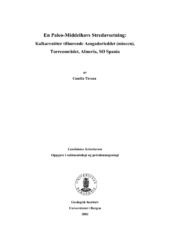| dc.description.abstract | The Vera basin is one of several small, intramontane Neogene basins which developed within the Alpine nappes of the Betic Cordillera of southeastern Spain. This system of interconnected basins acted as a marine strait linking the Mediterranean Sea with the Atlantic Ocean during the Tortonian and Messinian. A narrow seaway between the Vera and Sorbas basins was probably an important element of this strait. The marginal and axial infill of this seaway, represented by the Azagador Member, Turre Formation (Upper Tortonian - Lower Messinian), has been the object of this study. This thesis reports the results of a detailed sedimentological analysis of the Azagador Member based on fieldwork carried out in a ten square kilometer study area in the Turre area, Province of Almeria, SE Spain. The Azagador Member here consists of an approximately 50 m thick succession comprising a coarse-grained mixture of siliciclastics and temperate carbonates embedded in basinal marl and silt deposits. The calcarenitic body rests with angular unconformity on the Tortonian marls of the Chozas Formation. Marls and turbidites of the Abad Member (Turre Formation) conformly overlies the calcarenites. Based upon sedimentological investigations, the Azagador Member is divided into eleven lithofacies representing a variety of depositional processes. The facies have been further grouped into four environmentally significant facies associations; Coarse-clastic shoreface (FA1), strait deposits influenced by shallow marine currents (FA2), continental deposits (FA3) and carbonate-dominated ramp deposits (FA4). The onset of the accumulation of the Azagador Member, which was related to a progressive rise of the relative sea level, resulted in inundation and erosion of the basin margins and the establishment of a wave-dominated shoreline. A relatively steep shoreface caused resedimentation by sediment gravity flows and rapid accumulation of coarse-grained calcarenites into the shallow strait of the southwestern Vera basin. These sediments were prone to reworking by exceptional strong currents, reinforced by the narrow geometry of the seaway. Combined storm- and tidal processes caused the migration of dunes, and the excavation of giant channelized structures (100 m-scale). The Azagador Member strata have also been analysed within a sequence stratigraphic framework. Based on stratigraphic and geometrical field relationships, the calcarenites are subdivided into a lowstand wedge, a transgressive and a highstand systems tracts of a fifth-order cycle. The Azagador unit as a whole may also correspond to the lowstand wedge systems tract of a forth-order cycle. The development of depositional sequences in this small basin was controlled by the interplay between local tectonism and regional eustatic sea-level changes. The dynamics of this interplay together with the basin morphology and regional climate had a major influence on the sedimentation pattern in the intramontane seaway. In previous literature it has been emphasised that during the late Tortonian the Sierra Cabrera, which today form the southern margin of the Vera basin, were represented only by a small, submarine swell. However, paleocurrent measurements and evidence of episodic subaerial exposure documented during this study, clearly suggest a source area with significant relief along the southwestern margin of the basin during deposition of the Azagador Member. This implies that the Sierra Cabrera area must have been emerged at an earlier time than previously assumed. | en_US |
